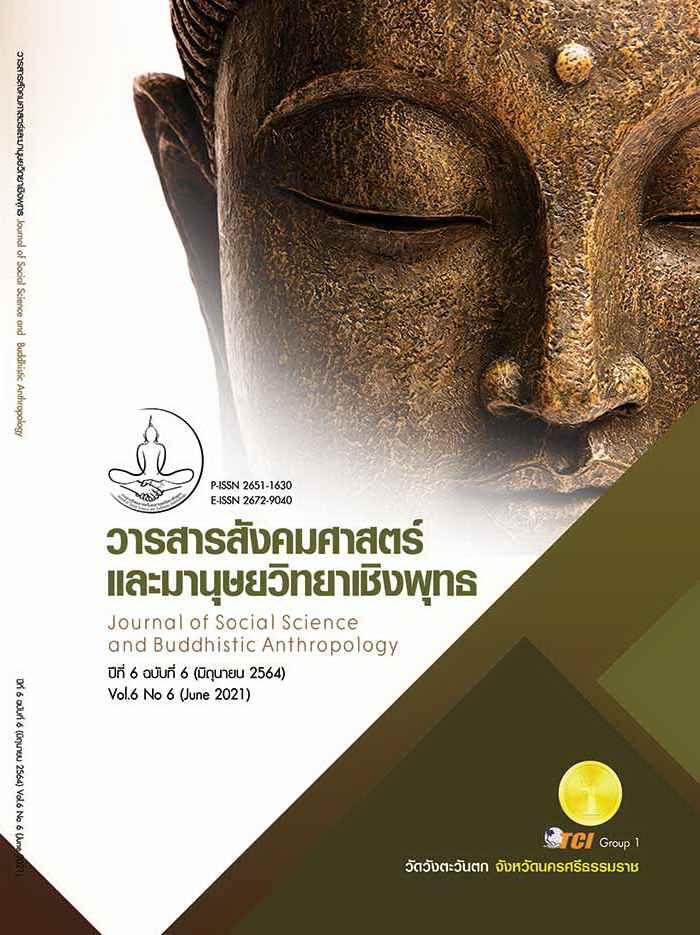DEVELOPMENT OF ENRICHMENT CURRICULUM TO ENHANCE PUBLIC MIND BASED ON SERVICE LEARNING AND COMMUNITY BASED LEARNING FOR UNDERGRADUATE STUDENTS
Keywords:
Enrichment Curriculum, Public Mind, Community BasedAbstract
The objectives of this article were to 1) develop enrichment curriculum to enhance public mind based on service learning and community-based learning for undergraduate students, 2) to examine the effects by comparing student public mind before and after the intervention, and student abilities to conduct the assigned public mind projects to achieve the set criteria of 70 percent, and 3) to explore the satisfaction of students and community stakeholders toward the developed curriculum. (using quantitative research) The samples were drawn from 24 undergraduate students from their first to fourth year of study at the Faculty of Education in Sakon Nakhon Rajabhat University. Tools included an assessment of public mind, an evaluation of student abilities in conducting the projects, a form of satisfaction. Statistics consisted of percentage, mean, standard deviation, t-test for dependent samples, and t-test one group. The findings were as follows : 1) The curriculum consisted of ten components : 1.1) background and significance, 1.2) basic concepts, 1.3) curriculum principles, 1.4) curriculum aims, 1.5) curriculum outcomes, 1.6) structural components of public mind, 1.7) curriculum structures, 1.8) learning activity management approach, 1.9) teaching and learning materials, and 1.10) learning measurement and evaluation; 2) The affects after the curriculum implementation revealed that the students’ public mind after learning through the developed curriculum was higher than that of before the intervention at a statistical significance of .01 level, and their abilities to conduct the assigned projects achieved the set criteria of 70 percent at a statistical significance of .01 level; and 3) The students’ and community stakeholders’ satisfaction reached at a high level. ( = 4.49, S.D.= 0.32) and (
= 4.47, S.D. = 0.12)
References
กองพัฒนานักศึกษา สำนักงานอธิการบดี มหาวิทยาลัยราชภัฏสกลนคร. (2559). แผนพัฒนานักศึกษา (พ.ศ.2559 - 2564) มหาวิทยาลัยราชภัฏสกลนคร. สกลนคร: มหาวิทยาลัยราชภัฏสกลนคร.
ณรงค์ ณ เชียงใหม่. (2545). การมีส่วนร่วมของประชาชนเพื่อการพัฒนาที่ยั่งยืน. วารสารรูสมิแล, 23(2), 1-7.
ธัญญาภัทร์ เลิศจันทรางกูร และคณะ. (2556). การพัฒนาจิตสาธารณะของนักศึกษามหาวิทยาลัยเทคโนโลยีราชมงคลกรุงเทพ. ใน รายงานการวิจัย. มหาวิทยาลัยเทคโนโลยีราชมงคล.
ปิ่นกนก วงศ์ปิ่นเพ็ชร์. (2553). ปัจจัยที่เกี่ยวข้องกับจิตอาสาของนักศึกษามหาวิทยาลัยเทคโนโลยีพระจอมเกล้าพระนครเหนือ. วารสารวิชาการศิลปะศาสตร์ประยุกต์, 3(5), 9-16.
พลวัฒน์ วุฒิประจักษ์. (2553). การพัฒนาหลักสูตรรายวิชาจิตตปัญญาศึกษาสำหรับนักศึกษาครูเพื่อเสริมสร้างคุณลักษณะบัณฑิตครูที่พึงประสงค์. ใน ดุษฎีนิพนธ์การศึกษาดุษฎีบัณฑิต สาขาวิชาหลักสูตรและการสอน. มหาวิทยาลัยศิลปากร.
ภัทรภร สีทองดี. (2559). การพัฒนารูปแบบการสร้างเสริมจิตสาธารณะของนิสิตในสถาบันอุดมศึกษาของรัฐ: กรณีศึกษามหาวิทยาลัยศรีนครินทรวิโรฒ. วารสารศึกษาศาสตร์ มหาวิทยาลัยบูรพา, 28(3), 63-74.
วัลลยา ธรรมอภิบาล. (2555). การพัฒนาหลักสูตรเสริมสร้างจิตสาธารณะ สำหรับนักศึกษาปริญญาตรีมหาวิทยาลัยทักษิณ วิทยาเขตสงขลา. วารสารศาสตร์มหาวิทยาลัยทักษิณ, 13(2), 62-79.
วิชัย วงษ์ใหญ่ และมารุต พัฒผล. (2552). รูปแบบการจัดการเรียนการสอนโดยเน้นสมรรถนะผู้เรียนเป็นสำคัญและการประเมินผลมิติใหม่. นครปฐม: มหาวิทยาลัยมหิดล.
สนิท สัตโยภาส. (2554). จิตตปัญญาศึกษา นวัตกรรมพัฒนาคุณลักษณะคนไทยที่พึงประสงค์ให้แก่แผ่นดิน. เชียงใหม่: สำนักพิมพ์มหาวิทยาลัยราชภัฏเชียงใหม่.
สำนักงานเลขาธิการสภาการศึกษา. (2560). แผนการศึกษาชาติ พ.ศ. 2560 - พ.ศ. 2579. กรุงเทพมหานคร: บริษัท พริกหวานกราฟฟิค จำกัด.
สุขมิตร กอมณี. (2556). โมเดลการจัดสภาพแวดล้อมทางการเรียนตามแนวจิตตปัญญาศึกษาสำหรับนักศึกษาระดับอุดมศึกษา. ใน ดุษฎีนิพนธ์ปรัชญาดุษฎีบัณฑิต สาขาวิชาเทคโนโลยีและสือสารการศึกษา. มหาวิทยาลัยมหาสารคาม.
สุคนธรส หุตะวัฒนะ. (2550). ผลของการใช้โปรแกรมพัฒนาจิตสาธารณะด้วยเทคนิคการเสนอตัวแบบผ่านภาพการ์ตูนร่วมกับการชี้แนะทางวาจาที่มีต่อจิตสาธารณะของนักเรียนชั้นประถมศึกษาปีที่ 3. ใน วิทยานิพนธ์วิทยาศาสตร์มหาบัณฑิต สาขาการวิจัยพฤติกรรมศาสตร์ประยุกต์ . มหาวิทยาลัยศรีนครินทรวิโรฒ.
สุพรรณิภา สายทองเยิ้น. (2556). การศึกษาวิธีการจัดการเรียนการสอนแบบการอภิปรายกลุ่มย่อยเพื่อส่งเสริมการคิดเชิงเหตุผลของนักศึกษาสาขาวิชาการศึกษาปฐมวัย ชั้นปีที่ 2. เพชรบูรณ์: มหาวิทยาลัยราชภัฏเพชรบูรณ์.








